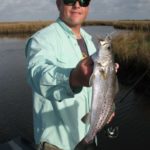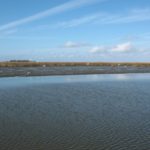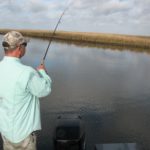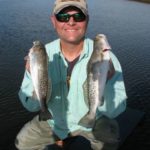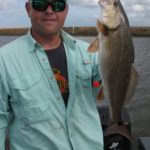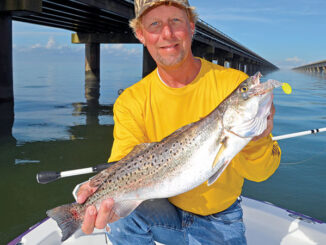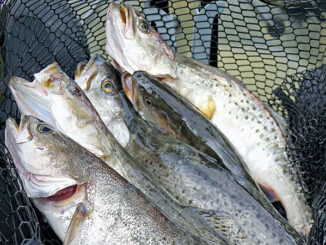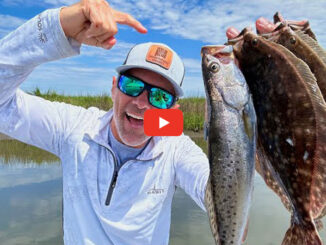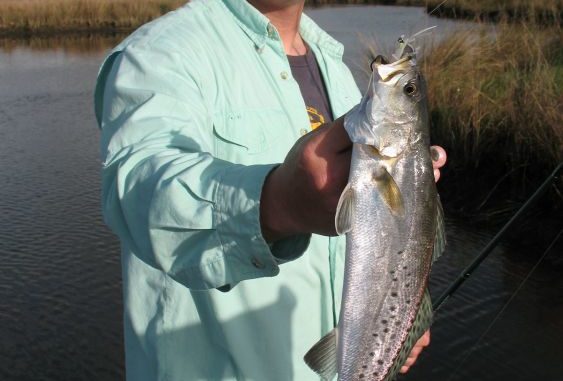
Trout that were ganged up near deep holes scatter this month as water temperatures rise, and that means boxes of fish are hard to come by. But this Hopedale guide knows the key to heading home with a slime-covered front deck.
Trout start acting squirrely in March. They’ve been cooped up for months — even confined — by the invisible border winter throws around the marsh.
Even when we have a mild February their instincts won’t let them wander far from their deep winter retreats.
But that invisible restraint completely dissolves on March 1, and the fish scatter like school kids on the first day of vacation.
Welcome to March, arguably one of the toughest months to find fish with any consistency.
Finding them one day doesn’t mean you’ll find them anywhere near that spot the next day. Many an angler returns from a March trip scratching their heads, wondering where the trout went.
To help decode the transition mystery, I called Capt. Marc Fradella (985-290-2908), a third-generation, life-long seafood wrangler and Hopedale-area charter guide.
I picked up my son-in-law, Shane Ansardi, and the two of us drove down to Fradella’s dock in Hopedale and climbed aboard his custom-made flatboat.
The boat is big, heavy duty and unique in that the entire boat is decked with heavy aluminum — so you don’t step down into the boat, you step up on top of it.
Even the center console and seat/ice chest sits on top of the decking. For safety, a grab rail runs along each side, nearly the length of the 24-foot boat.
There was an early morning chill in the air, so I came prepared with a jacket, even though the forecast was for a rapid warm-up, perhaps nearly reaching the 80-degree mark.
The thing to remember about those forecasts is that high temperature won’t be reached until late afternoon, and by that time you’ll be done fishing and back at the dock or already headed home.
Some people only hear the weatherman say “75 degrees will be the high today,” so they show up wearing shorts and T-shirts — but when the morning low is 55 degrees, that’s makes for a bone-chilling boat ride, and it could be hours before the temperature gets comfortable.
By March winter is nearly dead, though it may have one last icy gust to blow our way. But what it loses in chill, the month makes up for in wind: the blustery, howling, marsh-draining kind of wind when it howls from the north or west.
Which is what it did for the three solid days before our trip.
“Yesterday there wasn’t enough water under my dock to launch the boat,” Fradella said as we motored toward the MRGO. “It’s still very low, but not as bad as yesterday.
“All we can do is give it our best, and I think we’ll manage to put together some fish.”
While fishing might be tough, Fradella said one this is clear.
“The one thing you know for certain is the fish are still in the water, somewhere,” he said. “You just have to narrow it down from there.”
Our first stop of the morning was Lena Lagoon, where Fradella positioned the boat so we could drift with the wind and fan cast all around the boat.
The idea of fan casting is to have everyone fish a different side of the boat to try to locate some fish.
Once located, everyone can zero in on that area.
Fradella previously had a lot of success with a smoke/glitter H&H baby bull minnow, so he stuck with that.
I tossed a pearl Vudu shrimp, and Shane fished the same lure in shrimp cocktail.
We all fished under corks in the relatively shallow bay.
It was the Vudu that got the first bite, and the second and third and forth — but the trout were slightly undersized.
We moved a few times inside of Lena Lagoon, trying the middle, farther back and again to one side.
The surface of the big lagoon was calm, almost glassy when we arrived. But a falling tide kept the boat moving, and we were at times all slinging trout onto the deck.
But, again, they were all undersized.
Bays and bayous
Fradella said he’s got a system of how to approach the transition.
“On mild days I’ll start in the bigger interior bays and lagoons, just drifting and fan casting on all sides of the boat,” he explained. “Lake Ameda, Hopedale Lagoon, Lena, Lake Amedee, Tanasia — all have been producing fish.
“If you catch keeper-size trout, stick your Power-Pole or Cajun anchor down and see if other fish are around. Give it a few minutes, if nothing pops, move.”
But he’s not stubborn about fishing those areas.
“If the bays aren’t producing, then I’ll start fishing the bayous: St. Malo, Bayou Guyego and on up into the Biloxi Marsh if I can’t catch them any closer,” Fradella said.
The captain said he’ll reverse the plan after a spell of colder weather, starting in the bayous early and moving into the bays as the weather warms.
After making several drifts through Lena with nary a keeper trout in the box, Fradella headed for Bayou St. Malo.
“Anytime you make a fishing trip, you have to make judgement calls,” he said. “Do I fish the bayous or bays? Which bays do I try? If one doesn’t produce, do I switch to fishing bayous or do I try another bay? Do I stay in close or do I venture farther outside?
“All judgement calls. And you have to balance that against the clock. The farther you run, the less time you have to fish.”
Again, he bases these decisions on ore than just whim.
“I consider the factors: wind, water condition, and water temperature,” Fradella said. “I want to find decent, fishable water and not be beat up by March winds.
“So now we’ll try some nearby bayous and see what happens.”
The weather factor
Typically, the average high temperature in March is 72 degrees and average lows are in the mid- to upper 50s.
Winds month tend to be more from the north and northeast the first week or so of the month, becoming more easterly by mid-month — and by late March they blow mostly out of the east and southeast.
Wind speeds can vary from dead calm to 15 mph, with some 20 mph gusts thrown in for good measure.
Fradella followed Bayou St. Malo into the difficult section of the bayou between Lake Borgne and the long straightaway off Bayou LaLoutre.
I call it the difficult section because of all the twists, turns and washouts: If you’re not careful or if you’re unfamiliar with the bayou, you could easily wind up stuck on a shallow flat.
The boat was soon positioned across from a drain on the opposite side of the bayou, and Fradella stuck us in place with a stick pole.
It’s a pattern he would follow throughout the morning.
“The bayou isn’t real deep here, maybe 6 feet or so,” Fradella coached. “Fish out into the bayou and toward that drain — same baits under a cork.”
We fished that spot and caught a keeper trout or two, and then after nearly 10 minutes without another bite, we moved.
He ran just down the bayou a piece to another such drain or washout and stuck us again. Another trout or two and we moved.
Then we moved again, and then we moved again.
You get the picture.
March means move
The word “march” is more than the name of a month— it’s a verb that is applicable to how to fish the transition.
Putting together a decent box of fish in March requires action in the form of movement on your part.
“You really can’t park for long this month,” Fradella said. “The fish are scattered, but they’ll typically hang around places where they can forage, so cuts, shell banks, drains from the marsh and points are good places to try.
“I don’t give a place long to produce. I figure either the fish are there or they aren’t. If we go 10 minutes without a fish, I’m gone. Sometimes I don’t even wait that long, if I don’t like something I see, maybe the color of the water, lack of tide, too much boat traffic, etc.”
So you have to move and keep moving until you find some fish. They probably won’t be ganged up, so don’t expect to put a whole bunch in the boat in one spot.
“It is a transition month, which means trout are moving out of the winter patterns and probing farther out from the deeper interior,” Fradella said. “And if this winter is as mild as last winter, you may have to run to the bigger bays out near the edges to find the trout.
“Last year I fished the back-end of Lake Robin by Lake Coquille and over to Two Trees.”
His approach to these areas is pretty simple.
“I usually work my baits near the grassy islands and broken marsh, fishing the same way we’re fishing today, but I will bring some live shrimp along as soon as its available,” Fradella explained. “I also like to drift the bigger bays, closer to the lee side if its windy, and when I bump into action I’ll stick the pole down and try to add a few more to the count.”
Fradella said he also likes to fish the MRGO rocks this month.
“If I get a day when the winds cooperate, I like to fish the rocks two ways,” he said. “One, under a cork fished 3 to 10 feet off the rocks, and sometimes even a bit farther off them, and a bit deeper, say 3 to 4 feet under a cork.
“But I also like to fish a drop-shot rig at the rocks, 10 to 20 feet off of them or even a bit more. You can sometimes pick up some really nice trout that way, especially if you have some live shrimp.”
The latter tactic does present challenges.
“You have to be prepared to lose some tackle until you learn the technique of letting the sinker tap the top of the rocks on the bottom without allowing your line to settle down completely on the rocks, where it’ll snag up,” Fradella said. “I still snag up, so it’ll happen. Just be prepared to re-tie.”
We continued to follow his stick-and-move technique throughout the morning, adding one or two trout to the box at practically every move.
After perhaps 20 moves, we had a nice bunch of fish in the box — along with a nice, fat bass and a redfish.
So the March mystery isn’t really much of a mystery after all.
The trout are transitioning from the interior marsh toward the outside, where instinct drives them to spawn.
So they’re liable to be anywhere.
Some will linger in the deeper interior bayous for awhile, and interior bays also should hold fish.
All the main bayous and canals funneling water in and out of the marsh are natural highways trout travel, so pick an intersection and try an ambush.
But don’t stay anyplace too long, unless you are getting steady enough bites to keep you in that spot. If the bite is steady, stay. Even if the action is not fast and furious, better to steadily catch fish than to leave fish to look for fish, especially this month.
And if nothing is happening in the inside bayous and bays, burn some fuel and try the bigger bays nearer the outside waters.
One more thing: Fradella said the same things that work in March also will work in April.
Editor’s note: Capt. Marc Fradella can be reached at 985-290-2908.
